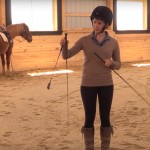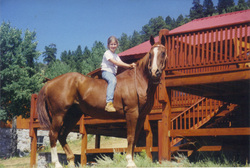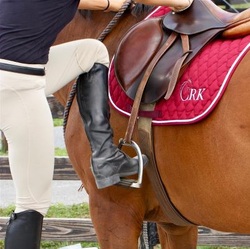Using a whip effectively can be a very important skill for riding, but even just holding one, let alone using it on the horse, can feel awkward and cumbersome.
In today’s video, I help you understand whips and how to use one effectively. We start by looking at different types of whips, then I show you how to use a whip, and give you suggestions for practicing.
Click play to watch the video below, then leave a comment with your thoughts or questions!
Callie














39 Responses
Hi Callie,
That is a great video, it makes so much sense and you explained the concept very well. I do have one question, if your whip is on the inside and you are just holding it (not tapping it) how do you keep the whip from poking the horse when he bends?
I just started to useing the whip i have found it very difficult at first but i am slowly getting used to poistioning it correctly inlove ur training videos thank you. and this one was very helpful i will start to practice with my right hand again thank you. for ur tips on helping us to be better more confident riders
Callie,
Great video on how and when to use a whip for riding. Quick question ~ which hand should hold the whip when you are riding? I can never remember and being right handed (and more capable using the whip with my dominant hand), prefer to hold it in that hand. Thanks Callie- on to practice!!
Nancy B
Hi Nancy, which hand to hold it in mainly depends on what you are doing. If you are trying to specifically activate one hind leg more than the other then use it in that hand. If you aren’t even thinking about the hind legs individually for your current riding level or for that particular horse then in my opinion it really doesn’t matter.
I’m going to send this to all the riding schools around where I live. SO many people out there have no idea and there’s so much smacking going on – the poor children don’t know any better. So thank you Callie for helping spread the word in the clear way you always do.
Thanks for sharing this Petra!
Hi Callie,
Thanks for the video! Do you have a video regarding boots, mucking boots and boots for walking the farm? I use rain boots for mucking and with all the walking I’m doing its starting to take a toll on my knees and hips. I have hard wood floors so we wear sneakers inside and we have our outside sneakers. I tried Ariat boots but you can’t wear them for long periods of time. If only thy made mucking boots with a sneaker bottom
Thank you for all your videos!
D.
I have a bad ankle and wear a brace in my shoes and boots. I love my Ariat boots and have even (accidentally because I forgot my sneakers) worn them for a 12 hour shift at work- I’m on my feet most of the shift. I’ve worn them for 3 days straight on camping and trail riding with no problems. Maybe you didn’t get a pair that fits your feet correctly?
if you truly want a sneaker bottom, look at the Ariat terrain lace or zip paddock boots. They look like a sneaker bottom hiking boot, but they are a true paddock boot. they even come in a waterprrof version. the sizes run a bit different from the Ariat leather paddock boots, but once you find the size they are very comfortable. Hope this helps!
-B.
Hi Daisy, I don’t have any videos on boots as footwear is often personal preference and for specific issues I am not an orthotics expert! For myself, I like a very flat shoe, without any support, so I like the “cheaper” Ariats that don’t have much arch support, but if you are experiencing pain I would talk to someone you trust who is an expert in this area and may be able to recommend insoles or something similiar.
Hi Callie,
So useful and very well explained as always. Thank you very much.
Will practice over the weekend.
Parag
Thanks for that video, Callie!
As a new rider I got confused on few last lessons when I was trying to do more of a tapping movement with the whip (or I should say “crop” as I was given the short one) and I was told by the instructor to hit/smack rather than constant tapping. Should I discuss in with my instructor or adapt to his way of teaching?
Next lesson is on two days so maybe I’ll try to do something about it.
Ola
Yes, wonderful stuff as always Callie, thank you so much for your efforts and input.
Tapping is definitely best, NO ONE likes to be hit! Having said that though, the other day I was circling/lunging a young grumpy fella who has always pinned his ears and threatened to swing his butt, so I tagged him firmly and carried on. Have felt I could have done better, but maybe THAT was a good response, I certainly don’t want to get nailed. Then changed to a longer line, grabbed my stick and string and felt much safer and comfortable.
cheers
Robyn
Hi Ola, I would ask your instructor, if the horse responds to what your instructor is asking they may be using the whip as a “wake-up”, to just get the horse paying attention again and listening to the other cues. It can work that way, but you want to be very careful if the horse starts unwanted behaviors with the use of the whip. For example, kicking a bit, pinning ears, etc.
Great video Callie ~ keep them coming 🙂
Hi Callie,
I’m so glad to see this informative video on use of the whip. My question is where should the whip make contact with the horse? I’ve seen both on the side rear flank and also the side just behind your leg. Maybe it depends on what you’re trying to teach the horse? Thanks for your help!
Amy
Is it “proper” to hold the crop or whip in the inside or the outside hand rather than always in the same hand? And if so… how do you gracefully switch hands without breaking rhythm or just looking like a major klutz!?
Also, does it matter where you tap the horse (in front or behind the girth, or on the hind end) or would it depend on what you are trying to accomplish and/or what length crop or whip you are using?
Great timing for me-my first time to use a whip for the first time was just last week during my lesson. It felt a little awkward but your suggestion to practice off the horse is a good one. Thanks again Callie for your wonderful videos!
Glad it helped Melanie!
Hi Callie, one thing I have a problem with is using the whip without affecting the rein. I find that I often pull back on the rein when trying to use the whip or drop contact. Do you have any tips to avoid this?
Hi Emily,
Two things, one perhaps try a different whip, I prefer ones that aren’t too stiff and more importantly are very lightweight, I find they actually take less wrist action to operate and make it easier to use the whip without affecting the rein. Second, just practice! It is a learned skill to use a whip well and give yourself some time to get the hang of it!
Hi Callie,
I’m so glad to see this informative video on use of the whip. My question is where should the whip make contact with the horse? I’ve seen both on the side rear flank and also the side just behind your leg. Maybe it depends on what you’re trying to teach the horse? Thanks for your help!
Amy
Hi Amy, technically you can use the whip anywhere and the horse will learn to repeat whatever movement or behavior stop the whip. For example, I have known some people who have horse vans with steep ramps and train the horse to walk forward from a tap on the chest. That said, if a horse has not had prior experience with the whip I find their first response is usually to move away from it. So the first time using a whip from the saddle might initiate a bit of a step over with the hind end but they will usually go forward quickly after that, so from the saddle I usually tap the flank. The white spotted pony showed in the few clips in this video had learned at some point to kick and buck in response to the whip, which is why it took so much longer to get him moving forward.
Hi Callie, Thank you so much for your video. I have a lesson horse that has learned to kick out and not go forward. When I ride her I always use intention (Caroline Rider) for forward movement first and she is fine. My better students also can ride her forward. It is my beginner students that have issues when riding her. They want the horse to go but are afraid of the horse going at the same time. I can see know that I have not coached them properly with the use of intention and then a steady tapping of the whip and have conditioned the horse to kick out and not wanting to go
forward. The scenario of your little grey pony is pretty similar to mine. I can now coach the students to have intention , and if that does not work, gently and persistantly tap until the desired behavior occcurs and then release pressure and reward forward movement.
Hi Nancy,
I definitly know what you are describing here! I have had the same challenges with my lesson horses. I find that using the whip actually helps them be able to “relax” and better use the idea of thought or intention. It’s almost as though too much thinking tends to make one tight, but being able to also use the whip in an easy, steady tapping fashion helps alieviate some of the anxiety of “why can’t I get him/her to go!”
Thank you Callie, I especially liked your advice of asking with the leg for a specific length of time and then begin the tapping of the whip. I was able to teach that to my students yesterday and it was fun for them to notice that the horse responded to the leg only cue fairly quickly after a few leg, then stick tapping. I love that you use gentle, repetitive tapping instead of letting things escalate.
Can you use this for downward transitions, say trot to walk? halt? How would you do it?
Fantastic video, I’ve learn’t a lot and my horse has today had a whole new whip experience with the ‘tapping’ – brilliantly simple and effective . I especially liked the thought provoking comments about horse behaviour correction and how it’s often poorly timed.
Hi Callie!
Great video! When you are applying the whip/tapping where are you making contact with the horse? My “go forward” cue from the ground is toward the hip. When in the saddle should I tap more toward the hip for consistency so the horse understands what I am asking for?
Hi Diane, Yes, you certainly can keep the whip tapping in the same specific spot for consistency! I find that the importance of this will be determined mainly by how many other cues you give with the whip. What I mean is that if the whip always means forward, no matter where it is used, then the horse learns to generalize very well and specific location of the tapping isn’t as important.
I appreciate the information on how to correctly use a whip. I agree that if you learnt o use a whip correctly it can be a very effective tool in riding and a lot of other situations. I would imagine it is also important to learn when to whip when riding as well so you don’t use it improperly.
Thanks Callie! This was so helpful. I got a dressage whip but was never really sure how to hold the whip and use the whip, without changing my reign position, or without confusing my horse. I am going to try to master it know that I have some exercises to work on.
So, So Happy and just Relieved to have found your site and look forward to learning more!! LOVE the tapping with the whip as I have a very unmotivated little mare whom I love and want to figure out! We have worked very hard with NH on the ground and building our relationship and trust for each other. She tends to intimidate me and cause some anxiety (Loved your calm and confident info and practicing that for myself) I think the tapping will be one more tool in my belt that she can understand and help us BOTH to move forward with confidence (pun intended!)
Thank you for this! Perfect timing!! I need to use a whip for my horse to make her go forward and was nervous using it, as you mentioned, I found I had too many things to handle in my hands. I will definitely try your tips to make it easier to use.
I hope these tips help during your next ride Diane!
-Julia Burdy, CRK Training Community Manager
very helpful!! I carry a shorter crop because we do longer miles on trail and need to learn a steadier pace. The shorter length is easier to tuck away. Reminders about limiting rider movement are particularly valuable! Thank you!
Hi Andrea, I’m glad you enjoyed this video! If you are using a shorter crop just use it behind the leg 🙂
-Julia Burdy, CRK Training Community Manager
What is the best way to use a crop? it is shorter and will not reach the hind area?
Hi Leah, you can reach the crop back behind your leg after putting both reins in one hand if you are comfortable riding like that!
-Julia Burdy, CRK Training Community Manager